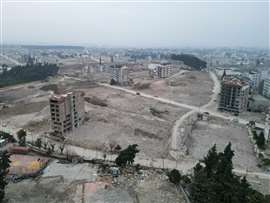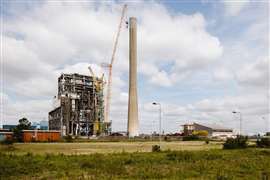Read this article in 中文 Français Deutsch Italiano Português Español
How Turkey is rebuilding a year on from devastating earthquake
19 April 2024
Turkey’s construction industry is still reeling from the effects of the devastating earthquake last year in which 50,000 people lost their lives. Lucy Barnard asks why so many buildings collapsed across the region and what challenges are facing rebuilding efforts.
For Kerem Güzel, corporate finance director of Turkish mega contractor Limak, the hours and days after last February’s terrible earthquake, will be etched on his memory forever.
“We were in a race against time to reach people under the rubble,” he tells Construction Briefing. “The initial hours and days following the disaster were critical to saving lives and supporting the affected communities.”
Some 50,000 people died when the quake, measuring 7.8 on the Richter scale, and its Mw 7.5 aftershock, hit the region last year. According to Turkish government figures, the quake destroyed or damaged around 214,000 buildings.
 Aerial view taken by a drone of Antakya city center of Hatay province in February 2024 show the devastating effect of last year’s earthquake. Image: Reuters/ SOPA Images
Aerial view taken by a drone of Antakya city center of Hatay province in February 2024 show the devastating effect of last year’s earthquake. Image: Reuters/ SOPA Images
Güzel says that in the first few days following the earthquake last February, with thousands still trapped in the rubble, desperate friends and relatives were begging anyone with heavy equipment to help.
Limak alone, says Güzel, sent a fleet of more than 200 pieces of construction machinery, from cranes to excavators, along with the company’s most experienced operators, which navigated through the rubble to assist the Turkish disaster agency (AFAD) and was responsible for rescuing more than 150 people from the debris.
The company also opened several of its guesthouses in the earthquake zone to survivors immediately after the quake, built a temporary city of shipping containers in Hatay to accommodate up to 4,000 people and partnered with other companies to establish more in various regions.
Certainly, Turkey’s five biggest contractors, which dominate the country’s largest projects – Limak, Cengiz, Kolin, Kalyon and Mapa – have been heavily involved in the country’s reconstruction efforts.
A key focus initially was the region’s main airport at Hatay whose runway had been split in two by the force.
Construction teams rushed to reopen the facility to commercial and humanitarian flights by 12 February in order to enable aid to reach the stricken region.
Repairing vital infrastructure
“Limak ensured a steady supply of cement for reconstruction works, including the runway of Hatay Airport,” says Güzel. “This was carried out in line with the post-earthquake recovery framework laid out by the government.”
Another focus has been repairing the region’s largest container facility, the century old port at Iskenderun, which lies just 37 miles from the airport, on the Mediterranean coast.
The four-berth port, which has been operated by conglomerate Limak since it was nationalized in 2011, suffered significant damage during the quake when a stack of containers topped over and caught fire causing a conflagration which took three days to put out and was only extinguished with the help of military helicopters and planes.
 Rescuers and citizens search for survivors in Hatay in February 2023 with the help of a Hidromek excavator (Photo: Reuters/Tunahan Turhan/ SOPA Images/Sipa USA)
Rescuers and citizens search for survivors in Hatay in February 2023 with the help of a Hidromek excavator (Photo: Reuters/Tunahan Turhan/ SOPA Images/Sipa USA)
“One of the docks in the port was swiftly restored to allow aid ships to dock and deliver necessary supplies including humanitarian aid and reconstruction materials,” says Güzel, who is also a board member for LimakPort.
“The port is a gateway for imports and exports for the southeast part of Turkey where very important industrial cities are located. In the aftermath of the earthquake LimakPort needed to resume its operation with the necessary capacity to support the region’s rapid economic recovery.”
Homes reconstruction effort
Turkish president, Recep Tayyip Erdoğan pledged to build 319,000 new homes “within a year” of the quake and a total of 680,000 a year later. Yet, fourteen months after the quake, reconstruction efforts appear to have slowed.
According to Kamil Yilmaz, a professor of economics at Koç University, just 75,364 of the promised 319,000 new homes to have been delivered in the year following the quake have been built.
In February this year, as he hailed the delivery of 7,275 new homes in Hatay, President Erdoğan said that a total of 200,000 new homes would be delivered this year (2024), according to a report by Reuters.
Meanwhile, Turkey’s urbanisation minister Mehmet Ozhaseki told reporters that 390,000 families were registered to received houses to be built in the earthquake region, with tenders for 200,000 apartments completed. Construction of some of those is underway, while the tender process for another 100,000 apartments continues.
One of the key reasons for the slower pace of construction appears to be a struggling Turkish economy. In March, the Turkish central bank raised interest rates to 50% - one of the highest rates in the world – due to rampant inflation which hit a 25-year high of 85.5% in October 2023 and remains at an official rate of around 70%.
Meanwhile, Turkey’s currency, the Lira, has continued to depreciate. Back in March 2021, one US dollar fetched around eight lira, today it can buy 32. All of this means that the cost of imported building materials has risen dramatically while the government’s decision to increase industrial electricity prices by 20% last year has also hit steel prices.
Of the 3 million left homeless by the disaster, many families are living in shipping container cities, crowding into plastic boxes measuring around 21 sq m (226 sq ft), which include a toilet and shower and room just large enough to fit a small sofa or single bed. Others are still living in tents, camping in destroyed buildings, or have been forced to leave the region.
Buildings not up to code
Halil Sezen, a professor in the department of civil, environmental and geodetic engineering at Ohio State University, part of a team of six civil engineers from the US-based Earthquake Engineering Research Institute (EERI) sent to assess the structural damage caused by the quake some five weeks following the disaster, says that many of the buildings he investigated were not built to the standards required by Turkish law.
 Kerem Güzel, corporate finance director at Limak. Photo: Limak
Kerem Güzel, corporate finance director at Limak. Photo: Limak
“We had two vans and were separated into two groups of three people with a local engineer or faculty member too,” he says. “We drove past scenes of massive destruction where everything was just rubble. At some locations the ground motion recordings was three or four times larger than what these structures are designed for. But this earthquake covered such a large area that there are cities and towns that there are many areas where newer buildings especially should have been able to withstand them but many still collapsed.”
Sezen says that Turkish building codes since 2000 are similar to current US codes, with strict requirements, for example, for contractors to use steel column ties at a minimum distance of 10cm apart with hooks embedded into the concrete at an angle of 135 degrees. Yet, he says, from his observations, it was clear that the rules were not enforced.
“We observed that the design and construction of many buildings in this region did not meet the requirements of Turkish building codes,” Sezen says. “All I can say is in many many many cases the rules were not followed.”
In the aftermath of the quake, the Turkish government has acted quickly to establish dozens of Earthquake Crimes Investigation Bureaus, charged with carefully looking into each collapsed building and checking to see if they were built to standard.
Builders, contractors, engineers and architects have been arrested across the country, some of whom were apprehended by police whilst attempting to flee abroad.
In March, building contractors Sedat Eser, Mehmet Şirin Yiğit and Şeyhmus Yiğit, and civil engineer Tevfik Demir were sentenced to more than 17 years in prison due to their role in the collapse of the Galeria shopping mall and residential complex in Diyarbakir in which 89 people died. According to the indictment, the contractors failed to comply with building safety codes and did not have the necessary soil tests carried out during the construction of the building. Three other defendants remain at large.
Contractors stand trial
The trial follows that of contractor Müslüm Demirer who in February was sentenced to 18 years in prison for his role in building the Osman Ağan apartment building in the city of Şanliurfa in southeastern Turkey which collapsed during the quake killing 34 people.
These sentences are being carefully observed by the defendants in other high-profile trials due to take place later this year.
These include eleven defendants who oversaw the construction of Adiyaman Grand Isias hotel which collapsed during the earthquake, leading to the deaths of 72 people.
They also include architect Mehmet Yaşar Coşkun, the founder of Turkish construction company Antis Yapi Group, the company behind Antakya’s Rönesans Rezidans which fell down during the quake, killing around 800 people, including former Newcastle United footballer Christian Atsu.
 People protest against government officials as they gather to commemorate the one-year anniversary of the devastating earthquake and remember their lost family and friends, in Hatay, Turkey, February 6, 2024. The magnitude 7.8 tremor that struck in the early hours of Feb. 6, 2023, levelled towns and city swathes in the country’s southeast. Image: Reuters/Dilara Acikgoz
People protest against government officials as they gather to commemorate the one-year anniversary of the devastating earthquake and remember their lost family and friends, in Hatay, Turkey, February 6, 2024. The magnitude 7.8 tremor that struck in the early hours of Feb. 6, 2023, levelled towns and city swathes in the country’s southeast. Image: Reuters/Dilara Acikgoz
For some, blame for the devastation also lies with public officials and the Turkish government.
Nine times, between 2002 and 2018, the Erdoğan administration has provided periodic “construction amnesties” which effectively provide legal exemptions for structures built without the required safety certificates.
These measures, which have proved popular with voters living in illegally built settlements, enable contractors to pay a fee to make the building legal – although the law was supposed to exclude any properties found to pose a threat to human life by inspectors.
“The latest catastrophic step in the whole system was the Zoning Amnesty regulations issued in 2018 in spite of strong objections from the experts and civil society,” says Oya Őzarslan, the chair of Transparency International Turkey.
“This process has not included any earthquake screening, and compliance with the earthquake building standards was left to the owners’ responsibility.”
|
STAY CONNECTED


Receive the information you need when you need it through our world-leading magazines, newsletters and daily briefings.
CONNECT WITH THE TEAM











